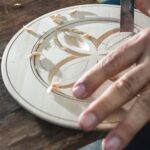Puppies are adorable creatures, but their natural instinct to chew and scratch can wreak havoc on woodwork in your home. If you’re wondering how to stop your puppy from scratching & chewing woodwork, you’re not alone. In this article, we’ll explore the dangers of this behavior, delve into the reasons behind it, and provide effective strategies to prevent it.
Puppy chewing and scratching woodwork may seem harmless at first, but it can lead to a multitude of dangers. Not only can it damage your furniture and trim, but it also poses a risk to your furry friend’s health. Splinters and ingestible debris from woodwork can cause choking hazards or serious internal injuries if swallowed. In addition, the chemicals used in treating wood can be toxic for puppies if ingested.
Understanding why puppies engage in this behavior is crucial in addressing the issue effectively. Puppies often chew and scratch as a way of exploring their environment, relieving teething pain, or seeking attention. By identifying the root cause of their behavior, you can implement appropriate solutions to curb it and keep both your puppy and your woodwork safe.
To address this common issue, implementing positive reinforcement training techniques is essential. It involves rewarding good behavior with treats or praise while redirecting undesirable actions gently but firmly.
In the following sections, we will explore how to puppy-proof your home, distract your puppy from woodwork, provide suitable alternatives for chewing, maintain discipline consistently, and seek professional help when necessary. By incorporating these strategies into your routine, you will be able to keep your puppy happy and protect your precious woodwork from harm.
Understanding the Reasons Behind the Behavior
Puppies are notorious for their love of chewing and scratching, and unfortunately, woodwork often falls victim to their destructive habits. Understanding the reasons behind this behavior is key to preventing it and keeping your home in one piece. One common reason puppies chew and scratch at woodwork is because they are teething, which can be painful and cause them to seek out objects to chew on for relief.
Another reason behind this behavior is boredom or lack of stimulation. Puppies, like humans, need mental and physical stimulation to keep them from getting into trouble. If they are not provided with enough toys or activities to keep them occupied, they may turn to woodwork as a way to entertain themselves.
Additionally, puppies may chew and scratch at woodwork as a way to seek attention from their owners. If they have learned that this behavior results in them getting scolded or interacted with in some way, they might continue doing it as a means of seeking attention. Understanding these reasons can help you address the behavior effectively.
- Provide a variety of appropriate chew toys for your puppy
- Engage in interactive playtime with your puppy
- Consider enrolling your puppy in obedience training classes
By understanding the root causes of your puppy’s wood-chewing habit, you can begin taking steps to address the issue and prevent further damage to your home.
Puppy-Proofing Your Home
When bringing a new puppy into your home, it’s important to consider that they will naturally explore their environment with their mouths. This means that woodwork such as baseboards, furniture, and door frames are at risk of being chewed and scratched. To prevent any potential damage and keep your furry friend safe, it’s essential to puppy-proof your home.
To effectively protect your woodwork and prevent your puppy from causing any harm, consider the following steps:
- Buy bitter-tasting sprays or deterrents that can be applied to wood surfaces to discourage chewing.
- Utilize baby gates to block off access to areas of the house where woodwork may be easily accessible.
- Keep valuable or delicate items out of reach while your puppy is still in the process of learning what is appropriate to chew on.
Additionally, providing ample mental and physical stimulation for your puppy through interactive toys and playtime can help redirect their attention away from woodwork. Remember that consistency is key in reinforcing good behavior.
By taking these proactive measures, you can create a safe environment for both your puppy and your woodwork. It’s important to be patient and provide guidance as your puppy learns what is acceptable behavior in their new home. With time and positive reinforcement, you can gradually train them to avoid chewing and scratching woodwork.
Positive Reinforcement Training Techniques
When it comes to preventing your puppy from scratching and chewing woodwork, positive reinforcement training techniques can be incredibly effective. Instead of punishing your puppy for exhibiting this behavior, it’s important to focus on rewarding them when they choose not to engage in these destructive habits.
Using Treats and Praise
One of the most popular positive reinforcement techniques is using treats and praise to encourage good behavior. Whenever you catch your puppy refraining from scratching or chewing woodwork, be sure to reward them with their favorite treat and plenty of verbal praise. This will help them associate avoiding woodwork with positive experiences.
Clicker Training
Another effective method is clicker training, which involves using a small device that makes a clicking sound as a marker for good behavior. When your puppy chooses not to scratch or chew on woodwork, use the clicker to mark the moment and immediately follow it up with a treat. Over time, they will learn that avoiding woodwork results in a tasty reward.
Redirecting Behavior
In addition to using treats and clicker training, you can also employ the technique of redirecting your puppy’s behavior. Whenever you catch them starting to scratch or chew on woodwork, quickly redirect their attention to an appropriate chew toy or alternative activity. By consistently doing this, you can teach them what is acceptable behavior in the home.
By implementing these positive reinforcement training techniques, you can effectively teach your puppy not to scratch and chew on your woodwork without resorting to punitive measures. Remember that consistency is key when it comes to training, so be patient and persistent in reinforcing good behavior while gently correcting unwanted habits.
Distracting Your Puppy From Woodwork
Puppies are naturally curious and playful, but their tendency to scratch and chew on woodwork can lead to costly damage and potential hazards. It’s important to understand the reasons behind this behavior in order to effectively distract your puppy from woodwork. One common reason for this behavior is teething, as puppies often seek relief by chewing on anything they can find.
Another reason could be boredom, lack of exercise, or anxiety. By understanding these reasons, you can better address the issue.
One effective way to distract your puppy from woodwork is by providing them with appropriate alternatives for chewing and scratching. This includes a variety of chew toys specifically designed for teething puppies, as well as durable toys that can keep them entertained and engaged. By offering these alternatives, you can redirect their attention away from your woodwork and onto items that are safe for them to chew.
In addition to providing appropriate chew toys, another method of distraction is through interactive playtime. Spend quality time playing with your puppy using toys such as tug ropes or squeaky toys.
This not only helps to physically tire them out, but also mentally stimulates them, reducing the likelihood of seeking out woodwork for entertainment. By incorporating regular play sessions into their routine, you can help prevent destructive behavior and keep your puppy happy and healthy while preserving the integrity of your woodwork.
Providing Proper Chew Toys and Alternatives
Puppies have a natural instinct to chew and scratch, especially during their teething phase. Providing them with proper chew toys and alternatives is essential in redirecting this behavior away from your woodwork. By offering suitable items for them to chew on, you can prevent damage to your home while satisfying their need to chew.
Choosing the Right Chew Toys
When selecting chew toys for your puppy, it’s important to choose ones that are safe and appropriate for their age, size, and chewing habits. Look for toys specifically designed for teething puppies, as these will be softer on their sensitive gums. Avoid toys that are too small and could pose a choking hazard, as well as ones that are easily destructible and could be ingested.
Introducing Alternatives
In addition to providing chew toys, offering alternative items for your puppy to gnaw on can also be effective in preventing woodwork damage. Consider giving them frozen carrots or rubber bones to soothe their sore gums during the teething phase. Rope toys can also serve as a great alternative for puppies who love to tug and chew.
Rotating Toys
To keep your puppy engaged with their chew toys and alternatives, it’s important to rotate them regularly. Introducing new textures, shapes, and flavors can keep them interested in their toys and prevent them from seeking out inappropriate items like woodwork. Remember that patience is key when training your puppy; providing proper chew toys and alternatives along with positive reinforcement will help steer them away from damaging your woodwork.
Consistency Is Key
When attempting to stop a puppy from scratching and chewing woodwork, it is important to be consistent with your discipline. This means setting clear boundaries and rules for your puppy and ensuring that everyone in the household follows them consistently.
Inconsistency can be confusing for your puppy, making it difficult for them to understand what behaviors are acceptable and which ones are not. Be sure to communicate these rules to everyone in your home so that your puppy receives consistent guidance.
One important aspect of maintaining discipline is redirecting your puppy’s behavior when they start scratching or chewing woodwork. When you catch your puppy in the act, firmly say “no” and then redirect their attention to an appropriate toy or activity.
Consistently redirecting their behavior helps them understand that woodwork is off-limits while providing them with an alternative way to satisfy their natural urge to chew. Additionally, reinforcing positive behavior with praise and rewards can help solidify the message that chewing woodwork is not acceptable.
It’s also crucial to remember that patience is key when maintaining discipline with a young puppy. It may take time for them to fully grasp what behaviors are expected of them, so consistency in enforcing rules and providing positive reinforcement is essential. With patience and persistence, you can effectively curb your puppy’s tendency to scratch and chew woodwork while fostering a harmonious relationship between you and your furry companion.
| Discipline Techniques | Explanation |
|---|---|
| Consistent redirection | Firmly say “no” and redirect their attention to an appropriate toy or activity when caught scratching or chewing woodwork. |
| Praise and rewards | Reinforce positive behavior with praise and rewards to communicate the message that chewing woodwork is not acceptable. |
| Patience | Understand that it may take time for the puppy to grasp expected behaviors, requiring patience and persistence in enforcing rules. |
Seeking Professional Help and Resources
Sometimes, despite our best efforts, a puppy’s chewing and scratching behavior may persist. In such cases, it might be necessary to seek the assistance of a professional. A certified dog trainer or animal behaviorist can provide valuable insights into your puppy’s behavior and offer specialized training techniques to address the issue. They can also help identify any underlying reasons for the behavior and develop a customized plan for your specific situation.
Another valuable resource is your veterinarian. While destructive chewing and scratching are common behaviors in puppies, they can sometimes indicate an underlying health issue. Your vet can rule out any medical problems that may be causing the behavior and recommend appropriate intervention if needed.
In addition, there are numerous online resources, forums, and communities dedicated to pet training and behavior modification that can provide helpful tips and advice from experienced pet owners and professionals.
| Resource | Description |
|---|---|
| Certified Dog Trainer/Animal Behaviorist | Expert guidance on addressing destructive chewing and scratching behaviors |
| Veterinarian | Medical assessment to rule out underlying health issues causing the behavior |
| Online Resources/Forums | Valuable tips and advice from experienced pet owners and professionals |
Conclusion
In conclusion, it is important to understand the dangers of puppy chewing and scratching on woodwork. Not only can it cause damage to your home, but it can also be harmful to your puppy if they ingest splinters or toxic materials. By understanding the reasons behind this behavior, you can better address and correct it.
Puppy-proofing your home is essential in preventing your puppy from having access to woodwork that they can chew and scratch. This includes using bitter sprays or deterrents, blocking off areas where woodwork is present, and providing proper chew toys as alternatives.
Positive reinforcement training techniques have been proven effective in correcting unwanted behaviors in puppies. By rewarding good behavior and redirecting their attention away from woodwork, you can help them learn what is acceptable and what is not. Consistency is key in maintaining discipline and reinforcing the training to stop them from scratching and chewing on woodwork.
Remember, seeking professional help and resources if needed can also provide additional support in training your puppy. With patience, consistency, and proper guidance, you can keep your puppy happy and your woodwork safe from their destructive habits.
Frequently Asked Questions
How Do You Stop a Puppy From Chewing on Woodwork?
To stop a puppy from chewing on woodwork, it’s essential to provide them with appropriate chew toys and to supervise them closely. Redirecting their attention to chew toys will help satisfy their natural urge to chew and discourage them from gnawing on the woodwork.
What Can I Put on My Baseboards to Keep Dogs From Chewing?
A common way to prevent dogs from chewing on baseboards is by applying a bitter-tasting deterrent spray. These sprays are specifically designed to deter dogs from chewing on furniture, baseboards, and other household items. Additionally, ensuring that your dog has plenty of appropriate chew toys can also help redirect their chewing behavior away from the baseboards.
What Can I Spray on Wood to Stop Dog Chewing?
There are several products available that can be sprayed on wood surfaces to deter dogs from chewing. Bitter apple spray and citrus-based sprays are commonly used to discourage dogs from gnawing on furniture and woodwork. It’s important to test these sprays in an inconspicuous area first to ensure they don’t damage or discolor the wood surface.

Hi everyone! I’m a woodworker and blogger, and this is my woodworking blog. In my blog, I share tips and tricks for woodworkers of all skill levels, as well as project ideas that you can try yourself.





